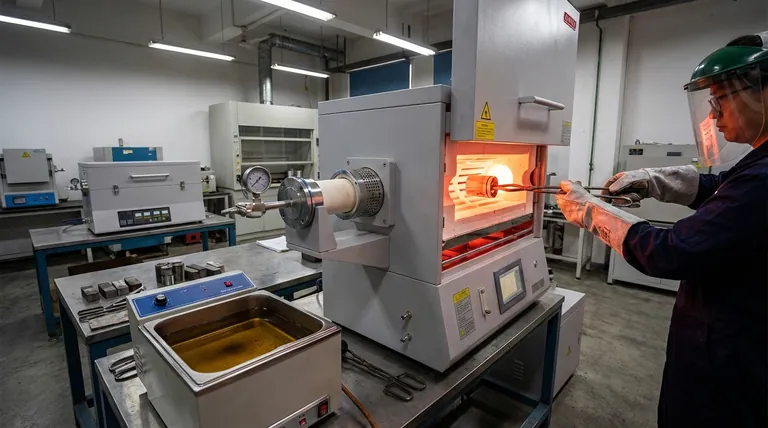In simple terms, hardening makes steel intensely hard but also dangerously brittle. Tempering is the essential second step that reduces some of that hardness to remove the brittleness, adding the toughness required for the material to be useful. They are two distinct stages of a single heat treatment process designed to achieve a precise balance of properties.
The core difference isn't just the procedure; it's the purpose. Hardening aims for maximum strength and wear resistance, while tempering is a corrective measure that introduces toughness, making the material resilient enough for real-world applications.

The Hardening Process: Creating Maximum Hardness
Hardening is the first and most dramatic stage of the two-part process. Its sole focus is to make the steel as hard and wear-resistant as possible.
The Method: High Heat and Rapid Cooling
To harden steel, it is heated to a very high temperature, often above 900°C. This alters the internal crystal structure of the metal.
Once it reaches the correct temperature, it is cooled extremely quickly, a process known as quenching. This rapid cooling traps the internal structure in a very hard, rigid state.
The Result: A Strong but Brittle Material
The resulting material is exceptionally hard and resistant to abrasion and deformation. This is ideal for applications requiring high wear resistance.
However, this process also introduces significant internal stress, making the steel as brittle as glass. A hardened, untempered piece of steel can easily shatter if dropped or struck.
The Tempering Process: Refining for Toughness
Tempering is always performed after hardening. Its purpose is to solve the brittleness problem created in the first stage.
The Method: Lower Heat and Controlled Cooling
The already hardened steel is reheated to a much lower, precisely controlled temperature. It is held at this temperature for a specific time to allow the internal crystal structure to relax and reform slightly.
This process relieves the internal stresses locked into the material during the rapid quenching of the hardening stage.
The Result: A Tough, Usable Material
After tempering, the steel is less hard but significantly tougher and more ductile. This means it can absorb impacts and flex under pressure without fracturing.
The final material has a useful combination of properties: it is still very strong and wear-resistant from hardening, but now has the toughness to withstand operational stress.
Understanding the Trade-offs
The relationship between hardening and tempering is a deliberate compromise between two competing properties. You cannot maximize both at the same time.
The Hardness vs. Toughness Spectrum
Think of hardness and toughness as being on opposite ends of a seesaw. The hardening process pushes the material all the way to maximum hardness, which means it has minimal toughness.
Tempering allows you to precisely control how far you back away from that extreme. By adjusting the tempering temperature, metallurgists can pinpoint the exact balance of hardness and toughness required for a specific job, such as manufacturing durable steel pipes.
Why Both Steps Are Necessary
Neither process is sufficient on its own for most applications. Hardened-only steel is too fragile, while tempering unhardened steel has a negligible effect.
The two-stage process is the only way to first achieve the high strength potential and then refine it into a durable, reliable final product.
Making the Right Choice for Your Goal
The level of tempering used is dictated entirely by the final application of the material.
- If your primary focus is maximum wear resistance with low impact risk: Use hardening followed by a very low-temperature temper to relieve just enough stress to prevent spontaneous cracking.
- If your primary focus is a balance of strength and impact resistance: Use hardening followed by a mid-range tempering process, which is common for tools and structural components.
- If your primary focus is maximum toughness for high-impact applications: Use hardening followed by a higher-temperature temper, sacrificing some hardness for superior ductility and resilience.
Ultimately, hardening and tempering are complementary processes used to transform raw steel into a material with the perfect blend of strength and resilience for its intended purpose.
Summary Table:
| Process | Primary Goal | Method | Resulting Property |
|---|---|---|---|
| Hardening | Maximize Hardness & Wear Resistance | Heat to very high temperature (>900°C) and quench rapidly | High hardness, but brittle |
| Tempering | Increase Toughness & Ductility | Reheat to lower, controlled temperature and hold | Reduced brittleness, added toughness |
Need precise thermal processing for your materials? KINTEK's advanced lab furnaces deliver the exact temperature control required for perfect hardening and tempering results. Whether you're developing tools, structural components, or high-impact parts, our equipment ensures consistent, reliable heat treatment. Contact our experts today to find the ideal solution for your laboratory's needs!
Visual Guide

Related Products
- 1700℃ Laboratory Quartz Tube Furnace with Alumina Tube Tubular Furnace
- Molybdenum Vacuum Heat Treat Furnace
- 2200 ℃ Tungsten Vacuum Heat Treat and Sintering Furnace
- Graphite Vacuum Furnace High Thermal Conductivity Film Graphitization Furnace
- Vacuum Heat Treat and Molybdenum Wire Sintering Furnace for Vacuum Sintering
People Also Ask
- How does a tube furnace work? Master Precise Thermal and Atmospheric Control
- What is the ceramic tube high temperature? From 1100°C to 1800°C, Choose the Right Material
- What tube is used for tubular furnace? Choose the Right Material for Temperature & Atmosphere
- What are the benefits of a tube furnace? Achieve Superior Temperature & Atmosphere Control
- What is the pressure on a tube furnace? Essential Safety Limits for Your Lab



















